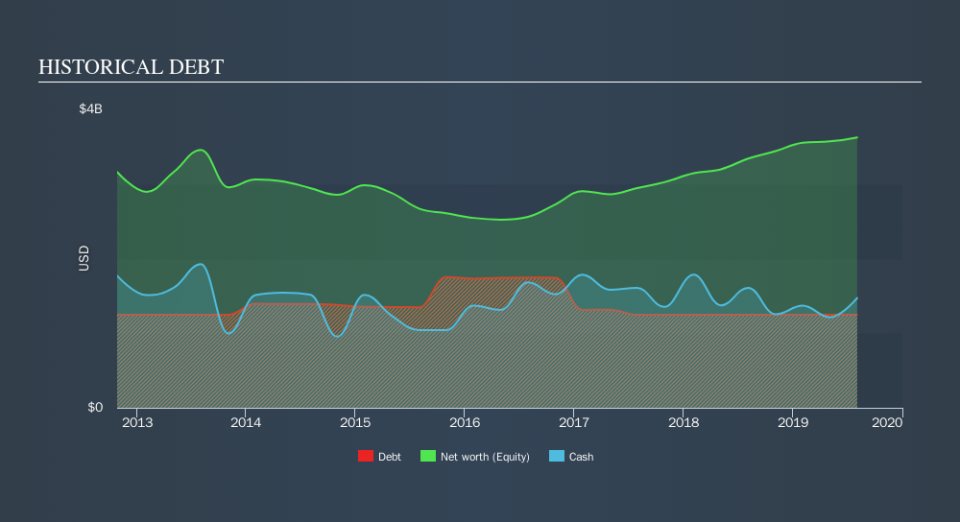Gap (NYSE:GPS) Takes On Some Risk With Its Use Of Debt

Some say volatility, rather than debt, is the best way to think about risk as an investor, but Warren Buffett famously said that 'Volatility is far from synonymous with risk. So it might be obvious that you need to consider debt, when you think about how risky any given stock is, because too much debt can sink a company. We can see that The Gap, Inc. (NYSE:GPS) does use debt in its business. But should shareholders be worried about its use of debt?
Why Does Debt Bring Risk?
Generally speaking, debt only becomes a real problem when a company can't easily pay it off, either by raising capital or with its own cash flow. In the worst case scenario, a company can go bankrupt if it cannot pay its creditors. However, a more frequent (but still costly) occurrence is where a company must issue shares at bargain-basement prices, permanently diluting shareholders, just to shore up its balance sheet. Of course, plenty of companies use debt to fund growth, without any negative consequences. When we think about a company's use of debt, we first look at cash and debt together.
See our latest analysis for Gap
What Is Gap's Net Debt?
The chart below, which you can click on for greater detail, shows that Gap had US$1.25b in debt in August 2019; about the same as the year before. However, it does have US$1.47b in cash offsetting this, leading to net cash of US$222.0m.
How Strong Is Gap's Balance Sheet?
We can see from the most recent balance sheet that Gap had liabilities of US$3.13b falling due within a year, and liabilities of US$7.28b due beyond that. On the other hand, it had cash of US$1.47b and US$359.0m worth of receivables due within a year. So its liabilities total US$8.59b more than the combination of its cash and short-term receivables.
When you consider that this deficiency exceeds the company's US$6.47b market capitalization, you might well be inclined to review the balance sheet intently. In the scenario where the company had to clean up its balance sheet quickly, it seems likely shareholders would suffer extensive dilution. Gap boasts net cash, so it's fair to say it does not have a heavy debt load, even if it does have very significant liabilities, in total.
Fortunately, Gap grew its EBIT by 2.4% in the last year, making that debt load look even more manageable. When analysing debt levels, the balance sheet is the obvious place to start. But it is future earnings, more than anything, that will determine Gap's ability to maintain a healthy balance sheet going forward. So if you want to see what the professionals think, you might find this free report on analyst profit forecasts to be interesting.
Finally, a company can only pay off debt with cold hard cash, not accounting profits. Gap may have net cash on the balance sheet, but it is still interesting to look at how well the business converts its earnings before interest and tax (EBIT) to free cash flow, because that will influence both its need for, and its capacity to manage debt. In the last three years, Gap's free cash flow amounted to 45% of its EBIT, less than we'd expect. That weak cash conversion makes it more difficult to handle indebtedness.
Summing up
Although Gap's balance sheet isn't particularly strong, due to the total liabilities, it is clearly positive to see that it has net cash of US$222.0m. And it also grew its EBIT by 2.4% over the last year. So although we see some areas for improvement, we're not too worried about Gap's balance sheet. In light of our reservations about the company's balance sheet, it seems sensible to check if insiders have been selling shares recently.
If you're interested in investing in businesses that can grow profits without the burden of debt, then check out this free list of growing businesses that have net cash on the balance sheet.
We aim to bring you long-term focused research analysis driven by fundamental data. Note that our analysis may not factor in the latest price-sensitive company announcements or qualitative material.
If you spot an error that warrants correction, please contact the editor at editorial-team@simplywallst.com. This article by Simply Wall St is general in nature. It does not constitute a recommendation to buy or sell any stock, and does not take account of your objectives, or your financial situation. Simply Wall St has no position in the stocks mentioned. Thank you for reading.

 Yahoo Finance
Yahoo Finance 
